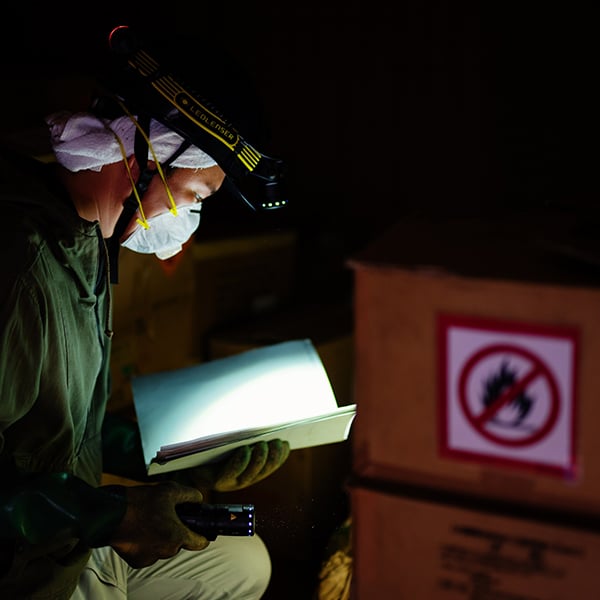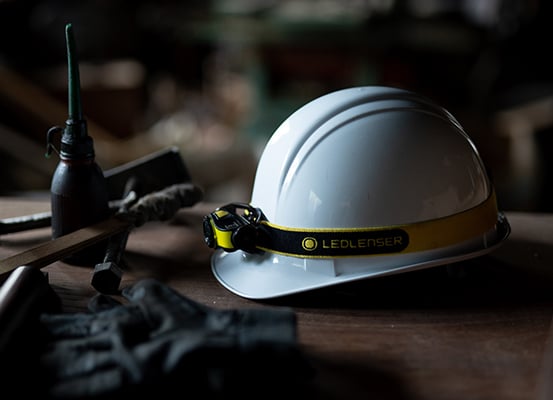
Definition - what are Ex zones?
Ex zones are areas in which there is the possibility of an ignitable concentration of flammable gases, vapors, mists or dusts. The risk of an explosion or dust explosion is high and can be life-threatening. In general, a distinction is made between two groups of substances:
- Gases, vapors, mists
- Dust
There are three Ex zones for each of these substance groups, making a total of six Ex zones. But it doesn't matter whether you are dealing with dust, gas, vapors or a flammable mist in the respective zone: The use of tools or flashlights, which can be a source of ignition, is a major hazard in any case.
What Ex zones are there?
Ex zones are areas in which there is a risk of explosion. The various Ex zones differ depending on the hazard situation or the occurrence of an ignitable concentration of flammable gas, dust or vapor.

Ex zone 2 or 22 Definition
Areas in which an explosive atmosphere occurs only rarely and for a short time are designated as Ex zone 2 or 22. Even if there is no legal regulation that precisely defines the "rare" or "short-term" occurrence, it is sufficient if an explosive atmosphere occurs for less than 30 minutes per year. A distinction is made between Ex zone 2 (flammable atmosphere due to gas, vapor or mist) and Ex zone 22 (flammable atmosphere due to combustible dusts).
Ex zone 1 or 21 Definition
Ex zone 1 includes areas in which an atmosphere with explosive vapors, gases or mists may occasionally form under normal conditions. Occasional occurrence is defined as when an explosive mixture occurs for less than 50% of the operating time, but for more than 30 minutes in total per year. If an area is designated as zone 21, it is an environment in which combustible dust must be expected.
Ex zone 0 or 20 Definition
Ex zone 0 is an environment in which an explosive gas atmosphere can occur frequently or for more than 50 % of the operating time. Similar to Ex zones 22 and 21, zone 20 is also characterized by the occurrence of an explosive dust mixture.
We have summarized detailed information on the respective Ex zones in the following table.
Ex-zone table
| Classification of the different EX zones | How often does an explosive atmosphere occur in the respective zone | Characterized by the presence of the following flammable media |
| Ex zone 2 | rare | Gas, steam, mist |
| Ex zone 1 | occasionally | Gas, steam, mist |
| Ex zone 0 | frequently | Gas, steam, mist |
| Ex zone 22 | rare | Dust |
| Ex zone 21 | occasionally | Dust |
| Ex zone 20 | frequently | Dust |
Directives for Ex zones
There are two so-called ATEX directives in the EU, which cover all applicable regulations for the sale and commissioning of devices and protective systems that may be used in potentially explosive atmospheres. ATEX stands for "atmosphères explosibeles" (French for potentially explosive atmospheres).
This directive is aimed at the operators of systems in which explosive atmospheres may occur and specifies the minimum requirements that must be met to protect employees. Among other things, measures are listed here on how employers can avoid explosion risks by selecting suitable work equipment.
The other directive is aimed at manufacturers of products that are used in Ex zones. Its aim is to ensure that all machines, systems, apparatus and devices used in the Ex zones meet the explosion protection requirements. For example, certain standards and temperature classes must be complied with for the individual device categories in the respective Ex zones.
The aim of the guidelines is to ensure that all persons present in explosion protection zones are protected in the best possible way and do not suffer any injuries. The requirements defined in the guidelines apply to every zone and system that falls under the areas listed in the Ex zone table.
What are temperature classes?
All devices intended for use in potentially explosive atmospheres are assigned to corresponding temperature classes depending on their maximum surface temperature. When using an appliance, care must be taken to ensure that the ignition temperature of the substance present in the Ex zone corresponds to the temperature class of the appliance. In simple terms, this means that only appliances whose maximum surface temperature is below the ignition temperature of the predominant substance may be used in Ex zones. When calculating the maximum surface temperature, a buffer is also added to prevent the appliance from igniting the substance in the Ex zone.
The following temperature classes exist:
| Temperature class | Ignition temperature of the substance | Maximum surface temperature |
| T1 | > 450° C | 450° C |
| T2 | > 300 bis 450 ° C | 300 ° C |
| T3 | > 200 bis 300 ° C | 200 ° C |
| T4 | > 135 bis 200 °C | 135 °C |
| T5 | > 100 bis 135 °C | 100 °C |
| T6 | > 85 °C | 85 °C |
If a device covers a high temperature class, for example class T5, it may also be used in the lower classes (T1 - T4). For dust-prone areas, the maximum surface temperature is indicated directly on the product instead of the temperature class.
A marking is printed on Ledlenser flashlights and headlamps with ATEX certification to inform you whether the ignition temperature of your lamp permits safe use in the respective Ex zone. You can also find the relevant information on temperature classes and Ex zones in our catalog.
The majority of our products are approved for temperature class T4 and maximum surface temperature for dusts of 135°C. This very good classification allows the handling of all common chemicals and substances, with a few special exceptions (subject to the fulfillment of other requirements, such as the correct zone).
What are gas and dust groups?
Not only the ignition temperature of a substance is relevant for the selection of suitable tools, attention must also be paid to properties such as the ignitability by electric sparks and the nature of the dusts. For this purpose, gases and dusts are assigned to specific gas and dust groups.
Gas groups IIA, IIB and IIC classify gases according to how easily they can be ignited by an electric spark. Substances in gas group IIC (e.g. hydrogen) are particularly easily ignited by electric sparks and therefore place the highest demands on products.
Dust groups IIIA, IIIB and IIIC classify dusts according to their properties. Dust groups IIIA and IIIB are non-conductive dusts of a coarse or fine nature (e.g. flour dust). Group IIIC consists of electrically conductive dusts (e.g. metal dust), which can lead to short circuits in electrical equipment and are therefore particularly dangerous. The highest requirements are therefore placed on tools with approval for dust group IIIC. Tools suitable for dust group IIIC may also be used in areas with IIIA and IIIB dust.

Flashlights and headlamps for hazardous areas
ATEX LED flashlights and headlamps from Ledlenser meet the strict requirements of the ATEX directive and are tailored in every detail to the requirements in potentially explosive atmospheres. Whether you are responsible for quality control in a paint shop, carrying out maintenance work in a refinery or inspecting a silo for wood pellets: our range of ATEX lamps for industry provides bright, spot-on light and is also suitable for illuminating larger areas.
All torches and headlamps in the EX series meet the requirements for devices for Ex zones 1, 2, 21 and 21 and temperature class T4. The EX4 and EX7 flashlights and the EXH8 headlamp are also approved for zones 0 and 20.
Our products are also generally approved for the best possible gas and dust groups IIC and IIIC. This means that our EX4 and EX7 products in particular can be used in almost any environment, with the exception of a few special substances with extremely low ignition temperatures.
In addition, the flashlights from our ATEX series are equipped with details such as a magnetic switch, which allows effortless operation with work gloves. Other features include the patented Advanced Focus System (AFS), which allows you to flexibly adjust the light beam. In addition to a sharply focused light beam for the long range, Ledlenser flashlights with AFS provide wide and homogeneous illumination at close range. Hardly any other ATEX-certified flashlight can compete with this.



